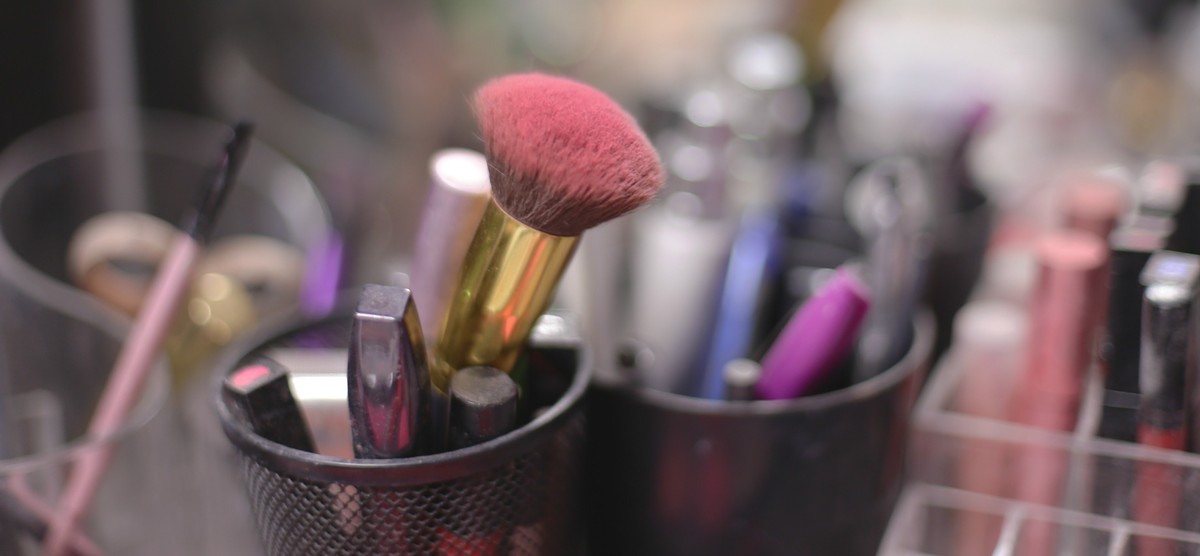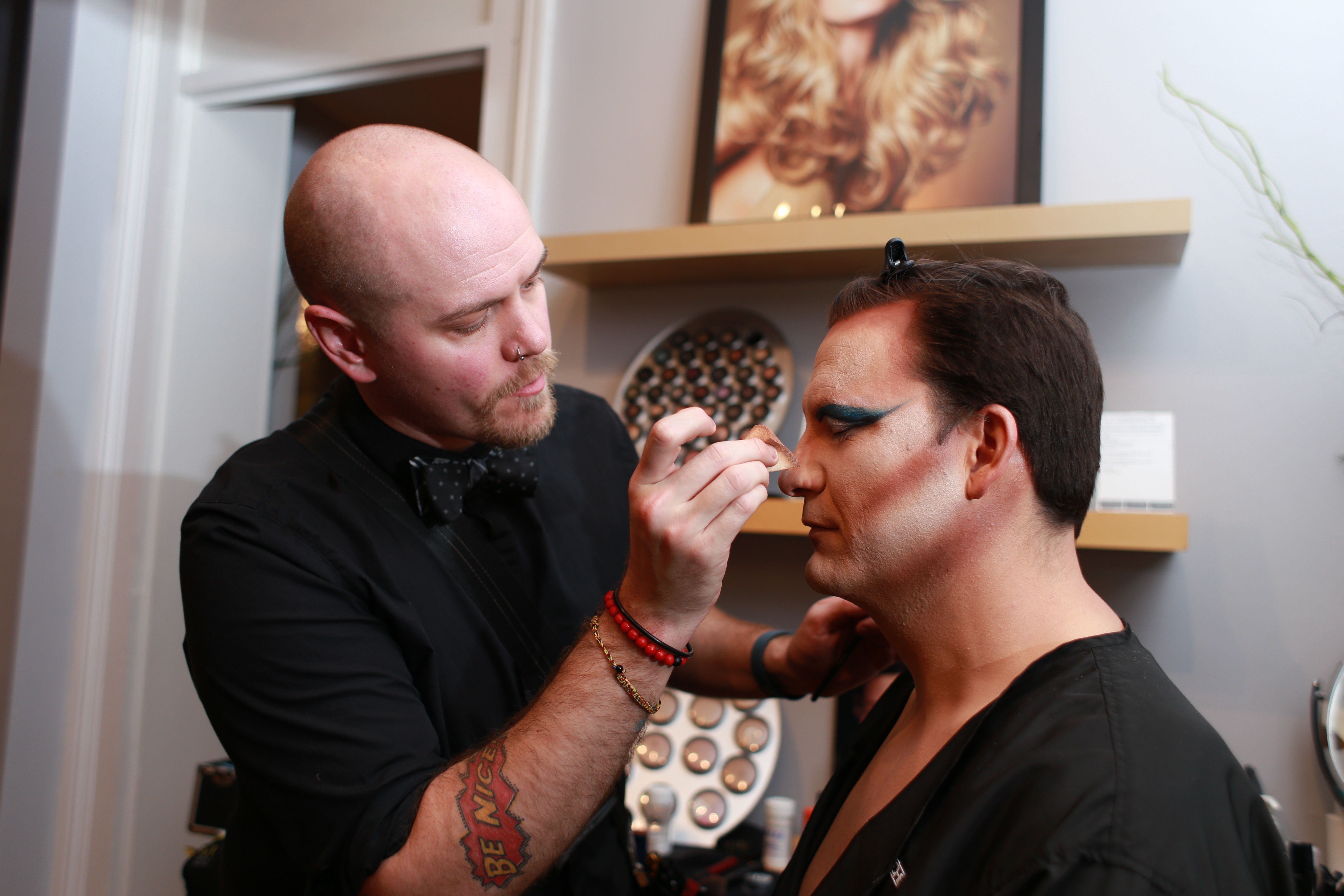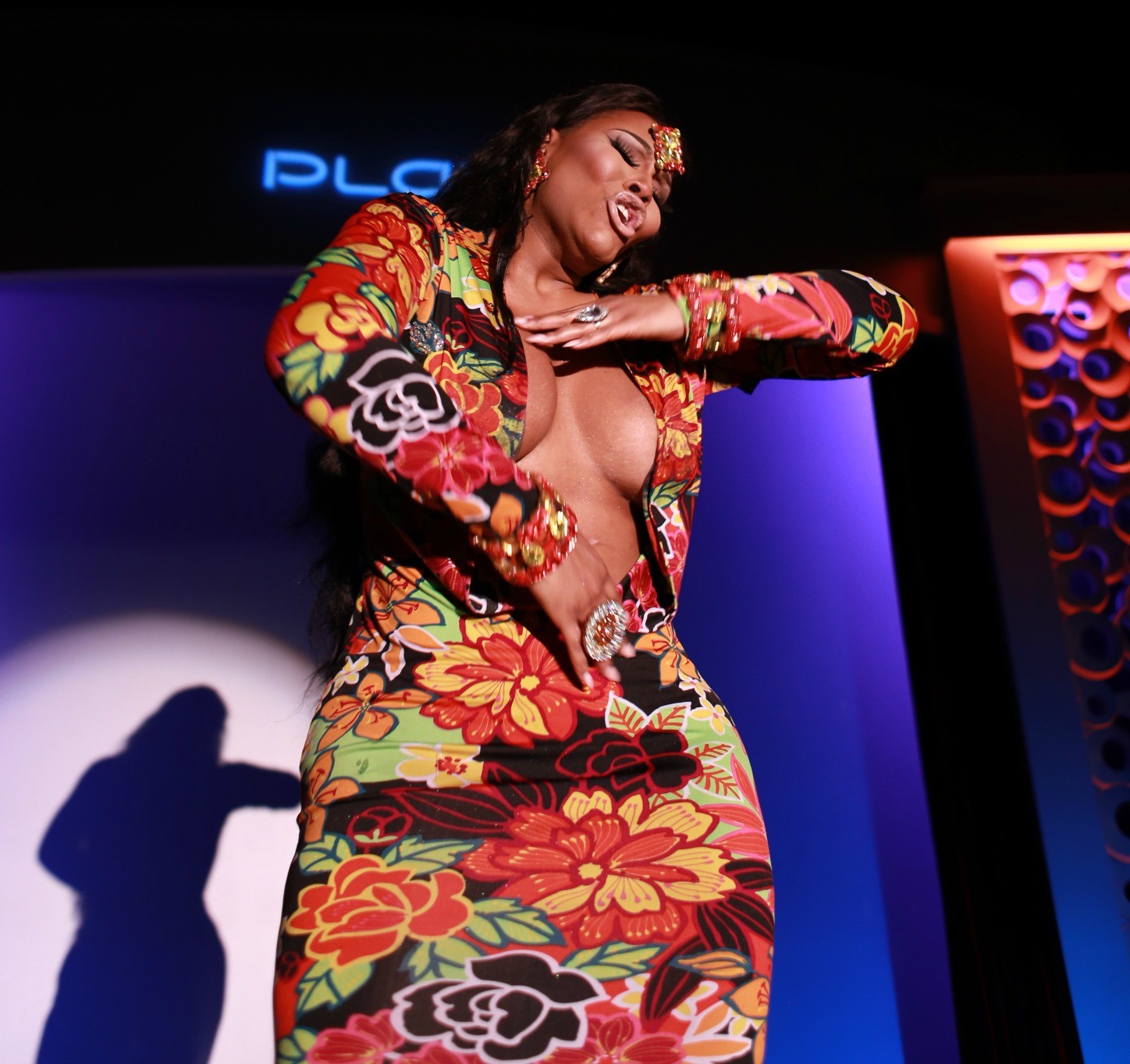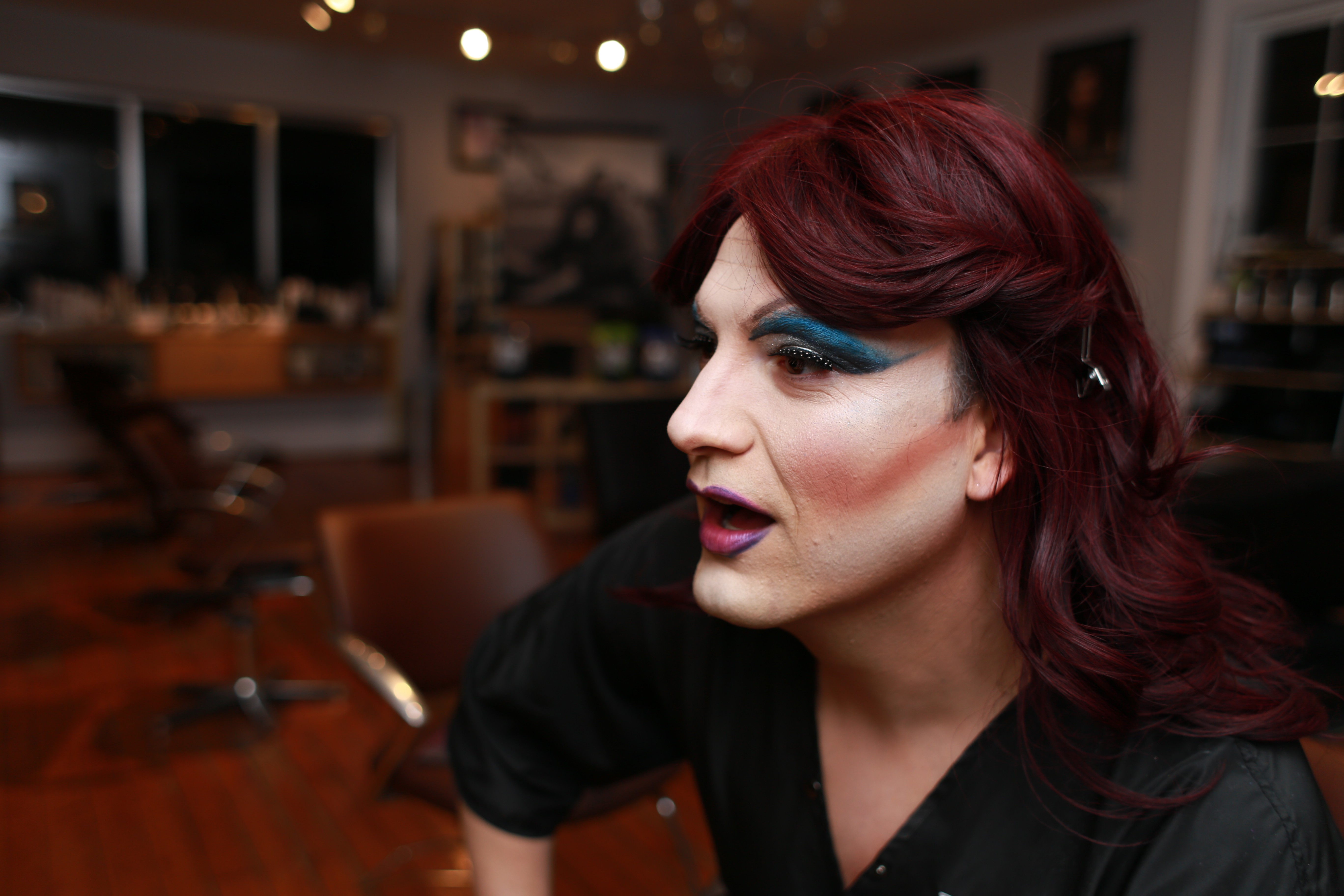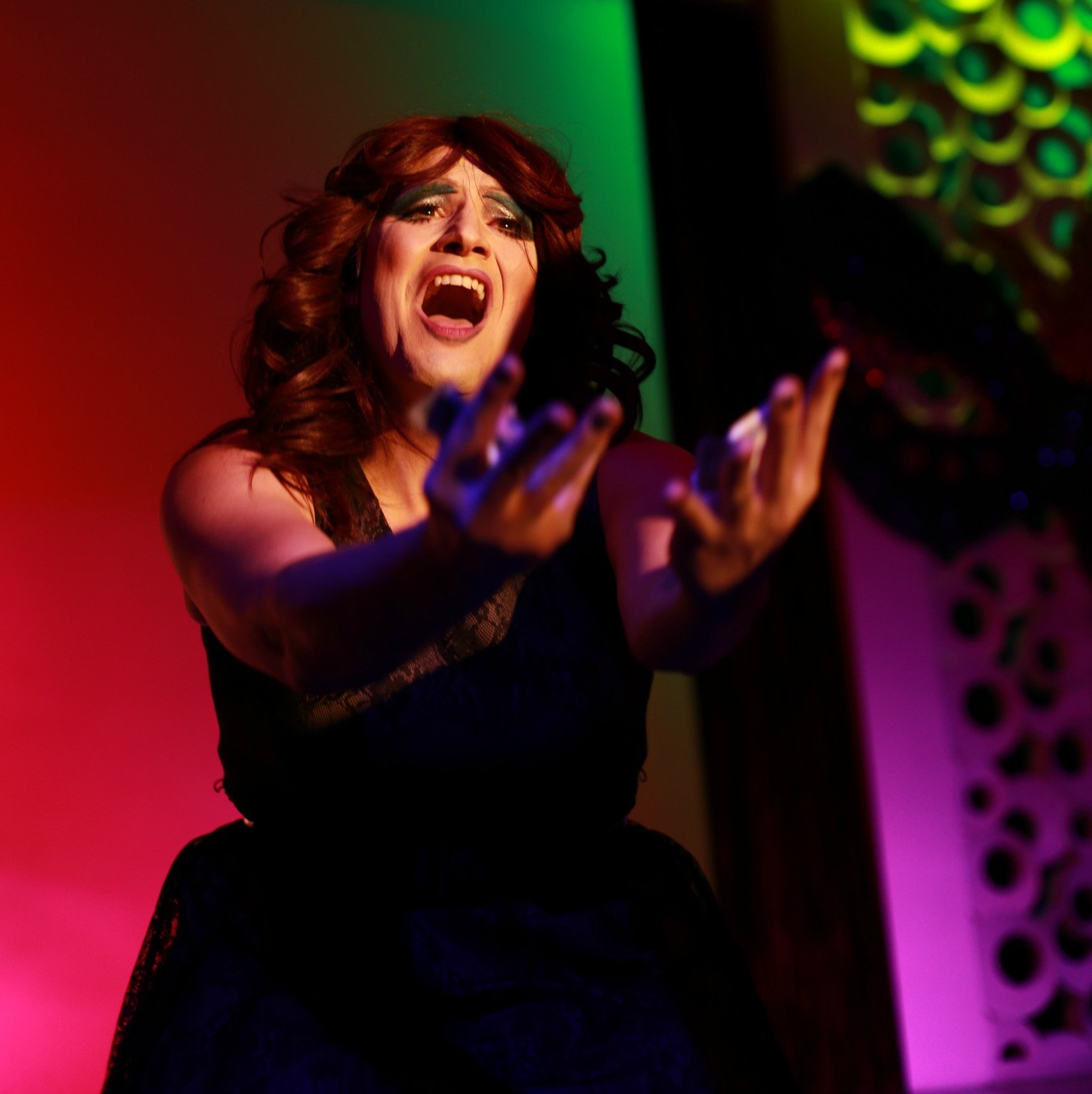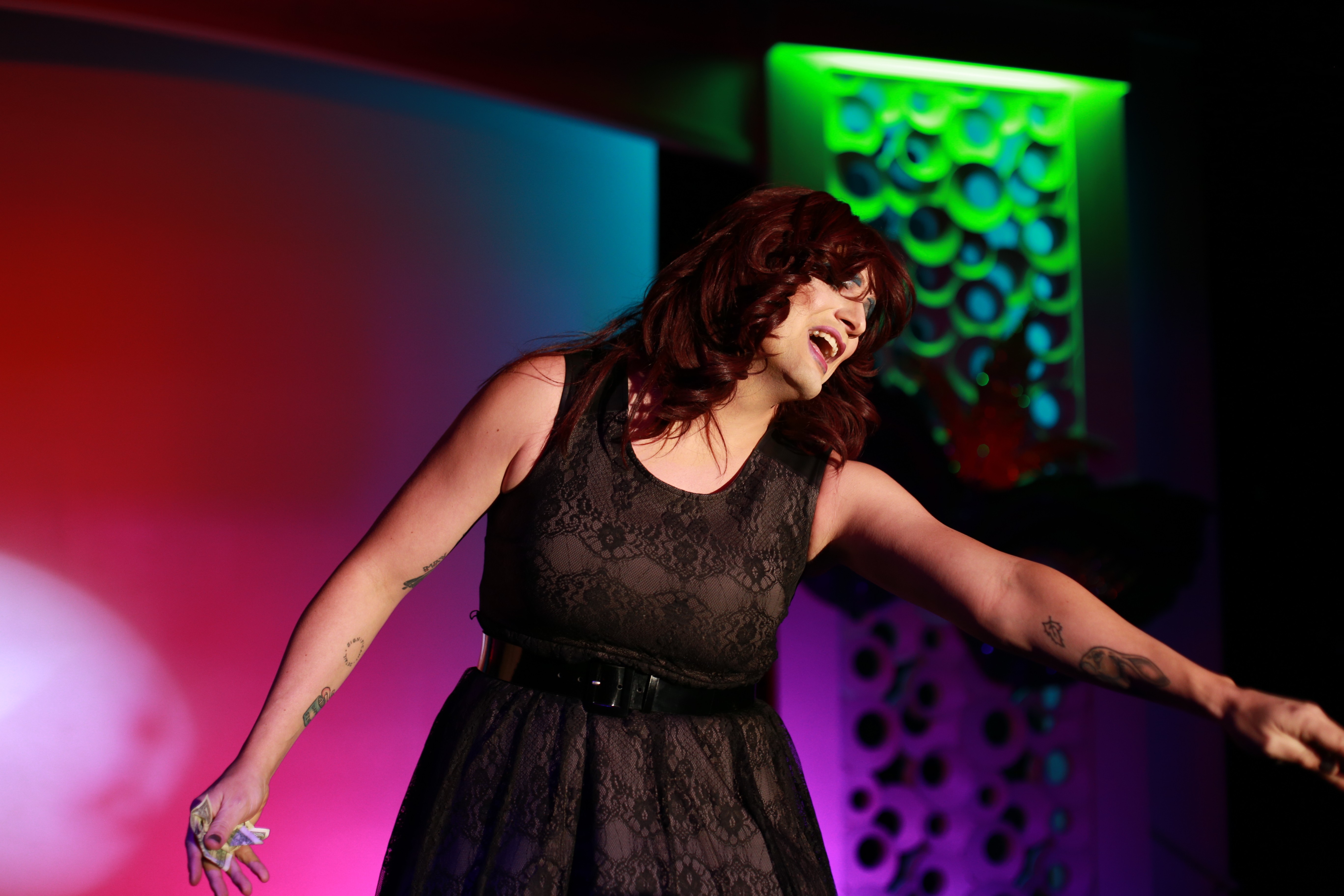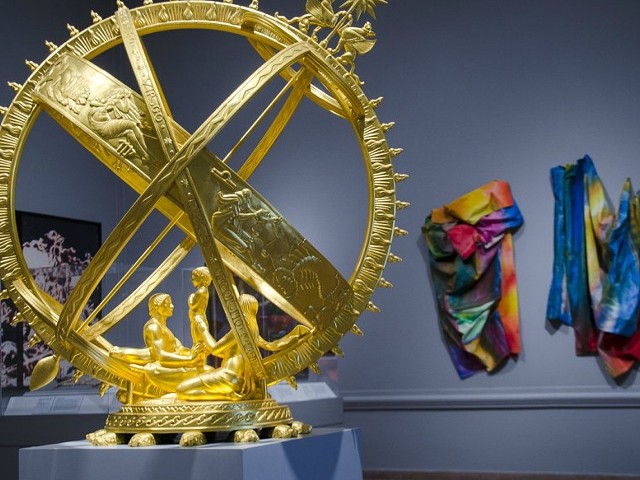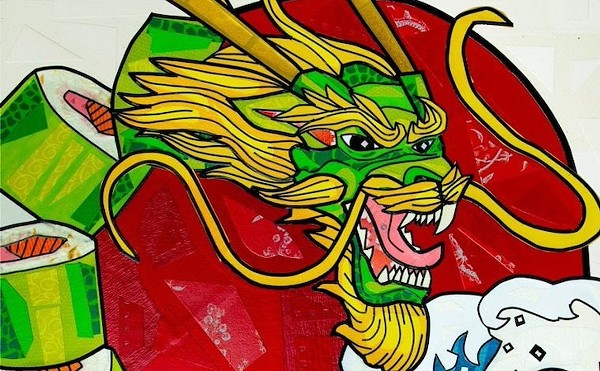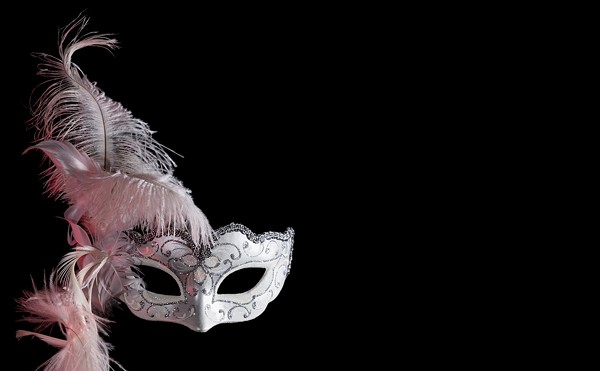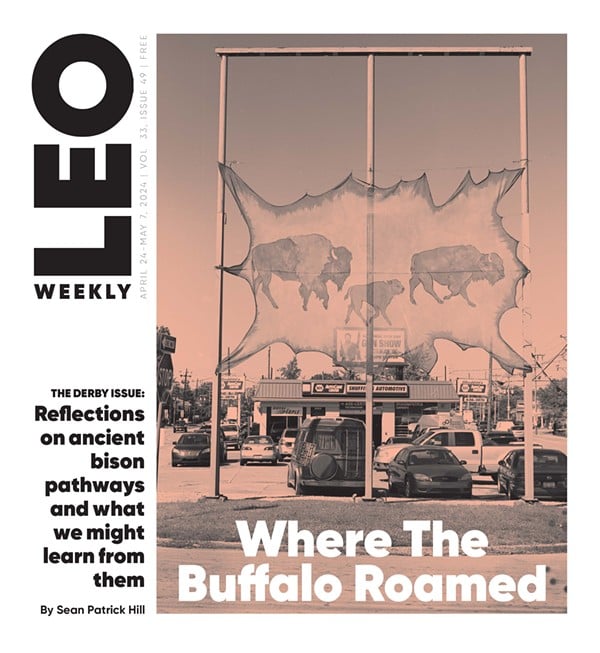[all photos by Edward Neary]
As Ryan Phillips, the Derby City Sister known as Velveeta VonTease painstakingly applied layers of makeup to my face, I found myself trying to remember the first time somebody called me fag.
Maybe it was at Toddle Town, the preschool I went to back in Alabama. I certainly got bullied there. But I think it really started while I was in first grade at St. Joseph’s Catholic school.
The “big kids” there, a handful of them anyway, these vicious sixth and seventh graders, liked to play this game after school. While we all waited for our rides, they’d walk around, plaid uniform shirts already untucked just moments after the bell rang, and kick the legs out from underneath younger students.
They’d kick you down, and then tease when you tried to stand up.
“Get up fag. Quit crying fag”
Then when you finally got up the courage to stand up, they’d kick your legs out from under you again. It seemed like this went on for hours, but it was probably just for a minute or two a day. Back then fag was just a word like pussy, used equally by the older kids to describe any one weaker than them.
As I got older it started to be a word that applied specially to me. It didn’t actually have anything to do with my sexuality, but I liked reading books of fairy tales, writing in journals and dressing the way I dress — nothing too crazy, just a certain expressiveness. To an ocean of assholes, these were clearly all marks of being a “fag.”
My family moved away from Alabama, and came to Kentucky. St James was a new school, but I had the same name: “Fag.”
I had been thinking about all of this in the weeks that I worked on this story, but especially while I was getting ready.
What I should have been thinking about was my outfit.
My dress, heels and wig needed to be on point. I should have been reviewing the lyrics to my song and the choreography. I was getting ready to try a new kind of performing, and when I got up on that stage I wanted to be flawless.
Talulah LeTease was getting ready to take the spotlight.
The Pitch
I’m no stranger to gay clubs. When you grow up in the performing arts, it’s just kind of the scene. There are almost always a couple of LBGT+ folk in each every show, and by some unspoken universal constant that holds true in all the places I’ve lived, when we go dancing as a cast, it’s always at a gay club. It’s partially informed by the fact that dancing too expressively or boisterously at a straight club used to always get you tagged with that aforementioned F word. It may still. I haven’t been to a straight dance club in years.But I’ve started to notice that the population of straight people in gay clubs seems to be drastically increasing. Play Louisville’s drag show is awash in bachelorette parties every time I go. Nowhere Bar seems to be half straight, half LGBT+ — a ratio that can dramatically change from hour to hour in the Bardstown Road club.
What do these changes mean for the LBGT+ scene in Louisville? What does it mean for that mainstay of club culture, the drag show? If this trend continues, will we reach a point where “Gay Club” is just a different flavor of watering hole, like an “Irish Pub” or a “Biergarten?”
And if it does, is our culture, and LGBT+ culture, losing something?
These are the questions I asked my editor when pitching a long-form piece on drag. Then to add an immersive something extra, I said I’d perform in drag, and report on that experience. I said it like it was no big thing, and, at the time, I didn’t really think it was.
I was wrong.
The Derby City Sisters
“In the very beginning the Sisters went out because they were trying to defy the Castro Clone, that kind of James Dean kind of energy, where everybody was in leather jackets and hyper masculine. They wanted to encourage people to see things from a different perspective, especially in terms of gender and gender expression,” explains Ryan Phillips, head of our local chapter of the Sisters of Perpetual Indulgence.The Sisters started in San Francisco in the late ’70s, and were on the forefront of the AIDS awareness movementand big into sex education. The local chapter, which Phillips helped start, has been active in Louisville for just over two years. They are fabulous, but they are also political and they are active. “There are aspects of this that I consider to be drag, and there are aspects of this that I consider to be social anarchy,” says Phillips.
As we talked, Phillips was “manifesting” at Focus Salon. The big mirrors and natural light offered a perfect setting for crafting beauty. By day, Phillips creates hairstyles at the Baxter Avenue salon. “Manifesting” is the term Phillips — and quite a few other drag performers I’ve met — use to describe getting ready. It’s not only makeup and a dress. It’s a spirit, a thought, a feeling. A persona. When Phillips is done manifesting, she’ll be Sister Velveeta Von Tease.
He was joined by fellow Sisters Ben Vivona (Tushie Galore) and Amy Pedigo (Agatha Jane). The trio was prepping for Sister Bingo, a monthly fundraising event held at Play Louisville. In the past, I’ve covered their Bingo, which raises funds for a variety of non-profits. When I started thinking about what drag means today and how club culture is changing, I knew I needed to talk to the Sisters some more, and they obliged.
There’s no uniform for the Sisters’ version of drag, but in general it isn’t the ultra-femme, super-realistic drag made popular by reality TV and clubs like Connections and Play. Many of the Sisters have facial hair, and they don’t shave their legs. The make up they wear is mix of clown white, abstract decorations, heavy eye make up, and, of course, fabulous fake lashes.
People, me included, often try to nail drag down, and make it one thing. It’s only men dressing up as women, or women dressing up as men. But that’s just not the case.
Case in point: Amy Pedigo is the first bio queen that I met doing my research. A bio queen is a woman that dresses up as a woman. While Pedigo isn’t changing her apparent sex or gender, she is still manifesting a part of herself, and exploring her identity. “I’m a lot more out there when I’m in character,” says Pedigo. “It’s made me come out of my shell. When you’re a Sister, people will just come up and hug you, and take pictures and want to talk.”
For these Sisters, drag isn’t about changing gender. That’s just a part of what’s happening. “It’s a way of looking at things without the traditional lenses. If you blur all the lines, then it’s no longer weird, there are no separations,” explains Phillips. Though at that point he was almost completely made up, and wearing an adorable white dress with huge black polka dots, so maybe I should attribute that quote to VonTease.
Blurring those lines is something that VonTease says is important even inside the LGBT+ community. “The culture here, and this is just from my perspective: I felt that it was really segregated and subdivided. The gay guys hung out with the gay guys and the lesbians hung out by themselves, and the straight bars are the straight bars.” VonTease saw even more specific segregations inside the gay community. “You still had the bear bar, and the leather bar, (and) you still had the twink bar.” VonTease is hopeful for the future. “I think that’s changing. I think we’re starting to realize we can all hang out and have fun together. I think it’s going to continue to change and evolve.”
Bio Queens and Burlesque
Tucked away in an unassuming storefront on Preston Highway is a little dive bar where the drinks are cheap and the clientele is a little surly. They aren’t mean, just a little wary of outsiders. On my recent visit, I was nervously sipping a soda with lime and trying not to feel like an interloper, which was tough since I was surrounded by middle-aged butch lesbians.I had been invited to Purrswaytions to see a performance by Artemisia de la Miel, a drag and burlesque performer that I first met in her role as a photographer working with Blue Moon Circus.
In the side room is a little stage. The bar and the stage aren’t grimy per se, but they have a lot more in common with The Mag Bar than a shiny dance club like Play, or one one of the newer gay bars on Bardstown Road like Big Bar or Chill Bar.
As the show gets closer to start time, the clientele starts to broaden a little. Younger LGBT+ folk start to pour in, and I realized I’ve come on goth night.
Black is my favorite color, and I’m no virgin to Smithian eye make up, but for some reason this day I’m wearing the squarest outfit I own — khakis and a blue button up. I feel desperately out of place.
The show finally starts and De La Miel takes the stage … as Jack Skellington. Through the evening she performs several numbers from The Nightmare Before Christmas, which of course kills with the goth crowd.
For this show, she was joined by a Burlesque performer named Ethel Lovelace, and two drag queens, Stevie Dicks and Felicia D Knight. Most of the evening’s drag performances are more confrontational, more in your face. It put me in mind of performers like Devine, who freaked out America back before it was fed the smoothed down and friendly versions of drag in films like To Wong Foo, Thanks for Everything! Julie Newmar.
A few weeks later, when we met for coffee and an interview, De La Miel explained the way she started finding the drag characters she wanted to perform: “Most of the Kings that I see on stage are a lesbian’s perspective on what masculinity is. So, the country guy, the thug, the Justin Bieber lesbian, it tended to be these stock characters that I did not find attractive, nor did I want to personify them.” De La Miel looked outside those identities of masculinity. Many performers have a single alter ego. But when De La Miel began trying to express her idea of masculinity, she didn’t limit it to one, and she didn’t always limit it to humans. Her characters include a male Navi from the film Avatar, Weird Al Yankovich, Jack Skellingtom and Rob Zombie. Oh, and Jesus. “For the past couple of years, I’ve been hired every Christmas and Easter as a Jesus impersonator. I do that a whole bunch,” De La Miel says.
She identifies as a “mostly femme queerio.” In addition to her performances as a drag king, she performs as a bio queen and does burlesque. She describes this as being “a female impersonator, portraying something that is like a Goddess.”
The way De La Miel dances back and forth between characters and onstage genders is fascinating, and maybe the clearest picture of what it means to really play with gender representations. She is so many different things, always moving and shifting.
Though she first tried drag and burlesque as a teenager back when she was first coming out, she honed her craft as a regular member of Play’s Thursday night cast, performing there for the first two years after they opened. She says the management was incredibly open and supportive of her experiments.
De La Miel left Play to start focusing on creating a performance group called The Bluegrass Bizarre Bazaar. The group mixes drag and burlesque with circus to explore identity and spectacle. Its first show is March 6th at the Cure Lounge.
Through the Bizarre Bazaar and her ongoing solo performances, De La Miel wants to keep trying new things and keep freaking people out: “It needs to be experimental, it needs to push the envelope.”
Drag is Expression
Do a long tracking shot through the front doors of Play Louisville, arguably the Derby City’s hottest spot for drag.Follow the camera around a corner, and through a door marked employees only. You find a drab dressing room with bare walls, made bright and friendly by the queens and kings getting ready for the night’s show, but keep going. Take another sharp left, and then another, and you’ll go through another door. Once that door opens you see a wonder, as you enter the dressing room of Play’s Playmates, the professional drag queens. Incredible costumes spill out of closets, pictures of high fashion are stuck to every available piece of wall. There is an unbelievable amount of make up at each mirror, and there are So. Many. Shoes.
Sitting in her spot, prepping for a Thursday night show, is Erin Morton.
“I was a shy, sheltered kid that grew up in a church. Didn’t know anything. Thought a condom was a condo. That’s how sheltered I was. I didn’t know what I was. I didn’t know what to call it,” Morton says. She is getting ready to put on her face. When she’s finished her make up and goes out on stage, she is the Playmate Akasha O’Hara Lords.
She’s an incredible presence, in person, and onstage. She’s a self-described black trans-woman. At 5’11, with a 44 Double D bosom and legs that stretch on until infinity, she is very feminine and even girlish just hanging out back stage in her sweats. She’s sweet and talkative, quick to laugh and unflinchingly open.
She described how it felt to discover herself: “I knew as soon as I got into college, and went to my first gay bar, seeing this whole exotic drag show going on.”
Now, Morton identifies as a trans-woman and a drag queen, but she remembers going home from the club that night to search the internet for the word “transgendered,” which she had never heard before stepping into that gay bar in Columbus, Ohio.
“I remember reading this list — ‘If you’re feeling, this, this, and this’ — and all these signs were there.” She began performing in drag. “Drag helped me become one with myself and become — instead of inverted — able to sit there and be like ‘Hey, I’m me, I’m happy, I’m comfortable, I’m able to express myself.’ ”
After talking to us for a few minutes, Morton began applying her make up. It’s hard to believe just how many steps are involved. I’ve now seen it done in real time, multiple times, and I still find the level of work and detail that goes into each face amazing.
There are layers or foundation, then base, then contours and highlights. Sometimes there is glue stick to smooth down natural eyebrows, then eyeliner, eye shadow, and mascara. For some, there are layers of fake eyelashes. There is lip liner, lipstick and lip gloss. For any one of those steps there could be one or more extra layers of a product, a special pre- or post-application that preps the face or adds an extra sheen or even mutes a gloss to a matte finish.
And that’s just the obvious stuff. There is blending, a skill that seems to separate the artists from the hacks. And all that’s just the face.
While Morton and I talk, there is a steady click of the camera.
It’s the first evening photographer Edward Neary is with me. On the surface, tonight, he appears to be a hip middle-aged guy. He uses the pronoun “he,” but he’s been getting ready to transition for several months, and soon he’ll start the process. Occasionally he’ll chime in with a thought about being trans or ask Morton about a specific make-up technique he sees her employing.
They chat briefly about Neary’s recent discovery that a damp eye shadow brush allows much more precise application. Morton subtly works it for the camera while addressing questions, and performing the miracle of applying make up.
As we chat about the process of preparing for the stage, Morton makes an off hand comment about hip pads and not needing them. I ask if she feels comfortable talking about the physical aspects of her transition.
It’s a delicate moment. As trans issues have entered the mainstream, the public has struggled to find the words and the manners to talk about things they don’t understand. I don’t claim to be an expert, and I’m learning along with everyone else. But the trans community seems fairly united in the feeling that you shouldn’t just assume you get to know what they have going on downstairs. Between Caitlyn Jenner and Laverne Cox, we’ve seen journalists asking questions in variety of ways and frequently doing so rudely and in poor taste.
Morton shoos away my timidity and tells me, “I’m an open book.”
“For me it, took time,” said Morton. “The one thing, when I first came out, and started doing shows, there was one trans-woman, she was beautiful, and she told me, and I still tell all the girls coming out, ‘Pretty girls take their time.’”
At the same time Morton was taking her time, she was dealing with trying to come out to her parents, a process she wasn’t able to complete. “My mom passed away in 2008, so I was never able to come out to her. But I think she knew,” Morton says.
She received a trust fund after her mother’s death, which her father turned over to her. Morton says her father told her “Go do what you gotta do.”
She didn’t completely come out to her dad until she got her implants done. “It’s a major surgery, and they’re like, who’s your emergency contact? So I told my dad. I remember crying on the phone to him, and he said, ‘Well, I love you, just call me when it’s over.’”
“My dad was like, we always knew, and we love you no matter what. We don’t understand it, but we love you.”
Later in the evening, my photographer and I slip out of the dressing room and find a table in the audience. When she hits the stage, her dress is cut down to her belly button and her impressive breasts are on full display, as is her hourglass figure. Her make up is, of course, on point. There is a large golden star affixed to her brow. The bubbly, girlish Erin Morton is nowhere to be seen.
This is Akasha O’Hara Lords, and she is a Queen.
The Oh Shit Moment
After interviewing O’Hara Lords, seeing her in her glory, for the first time, I start to really doubt my plan to shave my legs, do my face, find a dress and heels and manifest.What if I’m not pretty?
Sure, a 6-foot-3-inch bearded guy being afraid of not being pretty enough is kind of hilarious. But imagine for a second: The lights are on you, and every tool and trick you know about how to be attractive, cool, or tough, is useless, and you are operating under new and inscrutable guidelines. And the very first instant you try to do this is the exact moment you’ll be doing it in front of a crowded room. And you already invited your friends via Facebook.
At no point do I even consider calling it off. That’s simply not an option. Somewhere along the line, while working on this story, getting on that stage became more personal. It became a political action, a way to say “Fuck You” to every kid who bullied me on a playground and any person who ever thought they got to decide what being a man should mean for me or for anybody else.
In addition to all that is the urge I feel to make De La Miel, and O’Hara Lords, and especially VonTease, proud. What if I let them down?
To fight the rising panic, I start by picking a name. I reach back into my memories, and immediately, almost as if by magic, I remember my tendency to give cars, guitars and dogs the same name: Talulah.
Talulah.
But she needs a last name. While the vast majority of gay men I have known have been content to let me sing and dance and be my straight but sometimes effeminate self, there is an ugly word that a few aggressive men have used to describe me.
I take that word, forge it into a last name, and Talulah LeTease is born.
I’m working with full-on terror at this point. But I use the name like armor. Eli Keel may have pitched this story to his editors at the LEO, and he may have done hours of interviews, but he can’t help me now.
Only Talulah LeTease can save me.
My Drag Mother
In the drag community, there is a tradition of queens and kings adopting youngsters and helping them out. Teaching them makeup and stuffing and taping and padding and the thousand other secrets I still haven’t learned.Talk to any drag performer and they’ll tell you who their mother was. I suppose it’s not much different than the master/apprentice relationship that has existed in different trades throughout the ages. But it’s more intimate with drag. For so many people, the rejection, or even the fear of rejection, from their birth family, strengthens and empowers the bond between a drag mother and her youngsters. Drag is like family, and the nomenclature reflects it.
I didn’t really understand this bond at the beginning of the research process, when I started feeling around for someone to help me out with my manifestation.
Ryan Phillips, aka Sister Velveeta VonTease of the Derby City Sisters, began by offering me a dress, but she ended up being pretty much my Drag Mother. She helped me find a dress and heels. She did my makeup and found me a wig. I continually thanked her, and yet she always brushed it off. “Just doing my part to make the world a little more fabulous,” she says.
Safe Spaces
Before I got swept up in my own transformation, many of my questions revolved around what place a straight person has in a gay bar, and whether or not gay bars should exclusively be safe spaces for the LGBT+ community. I asked everyone I interviewed about this, and I got mixed answers.In the Playmate Dressing room, Erin Morton struggled to find an answer. This is a woman for whom the safe space of that club in Ohio helped her understand her true self, but she’s also a performer whose job depends on the commercial success of Play, which is bolstered by straight people.
“I hate it when people say, ‘This is a gay bar, that’s a straight bar.’ In order for us to get rid of people’s mindsets, in order for close-minded people to get out of that mentality, we have got to get out of that mentality. Any bar can be anything,” Morton says. She paused and added, “But I’m not gonna say it’s not necessary. There is something that is lost in not having that (safe) space.”
De La Miel sees it as more of a generational difference, noting that many of the more old school gay bars cater to an older crowd. “The internet is changing it. Used to be gay bars where were you went to meet people. If you had to be secretive about your lifestyle or identity, gay bars where you go to be able to be free about that. But, with the Internet, people can meet each other outside of the bars, it becomes less necessary to have those spaces.”
But she still recognizes the need for young people to have a safe space to be themselves: “I mean, there may always be problems, hopefully not for long, but for the foreseeable future, there will be problems for queer and trans youths, so having the gay bars be a safe space for that is important.”
For the Derby City Sisters, the confrontation of people seeing something they aren’t used to is part of the mission. They want to have the conversations. They take precautions to stay safe out in the world, and they bring security; “a masculine presence,” as Phillips puts it.
Phillips described a frightening experience when one of the sisters — he chose not to say who — was confronted by a drunk straight person in the bathroom at a local gay bar. “We handled it beautifully, and it ended up becoming a lovely conversation with this particular gentleman. But it was certainly cause for concern.”
Then again, it isn’t just straight people who can feel confronted by the sight of the sisters. “I’ve run into just as many gay people who are uncomfortable with the idea of of the sisters initially as I have run into straight people who are uncomfortable initially,” said Ben Viviona, aka Sister Tushie Galore.
The Day of The Show Ya’ll
Play Louisville offers an open stage twice a week. It’s a lot like an open mic, when a bar lets any idiot with a guitar get up and sing, but hopefully more fabulous. It’s an unseasonably warm Wednesday night when Talulah first manifests in all her glory. My prince, my queen, my drag mother Ryan Phillips does my make up and wig at Focus Salon. In the real drag world, I’d be doing my own make up and wig, and the skill it takes to do those things is part of what makes someone’s presence on stage so impressive.When I get to Play, with my photographer in tow, I head back stage to put on my dress and heels and get ready to go onstage.
The other performers are intimidating — so confident and beautiful — but they are all incredibly nice to me and to each other. Makeup is shared, wigs are borrowed. For these people, drag is a weekly thing, if not more often than that, so there is a hum of comfortable activity as they prep and talk song selection.
The next hour is agony, as I wait for my turn on the stage. I’m pacing back and forth. I put on my heels a half hour before I go on and practice walking.
Finally it’s time.
I walk down the hallway from the dressing room, and wait for Leah Halston, the Playmate who’s mc-ing the show, to call my name.
“Welcome to the stage, Talulah LeTease!”
The opening strains of Taylor Swift’s song “I Know Places” sails out of the speakers, and I walk onstage.
The Wrap Up
What started as a clever hook for a long-form story ended up being a lot more to me. And I know I’m not the only one who suffered as a kid for straying outside their rigidly assigned gender norms. Kids are still suffering; teens are still ostracized. Probably, right now, there is a kid on a playground somewhere, getting pushed down because he likes to dance instead of play football, or because she likes to climb trees and play basketball instead of play princess. For each of those kids, and for me, then and now, we were just trying to be ourselves.Everyone I talked to for this article had a slightly different definition of drag — the definitions ran from anarchy to transformation and back. But maybe my favorite came from Erin Morton — Akasha O’Hara Lords — just moments before she stepped out onstage at Play: “Drag, to me, is expression. Just be free to do whatever you do. It doesn’t matter if you’re gay, straight, bi — it’s all about just get onstage and have fun.”
Maybe someday we’ll all get to the point where that’s all gender is. Some fun performance, something as harmless as stepping onstage and lip-syncing your favorite song. Little kids — boys and girls and non-binaries and whatever — won’t have to worry if the kids on the playground are going to call them fags or pussies, dykes or tom boys. Sisters won’t have to worry about getting accosted in bathrooms. Trans-men and women won’t have to explain who they are to confused and frightened transphobes, or even nosy reporters. We’ll all be able to stand up and express ourselves.
And no one will ever kick our legs out from under us, ever again.

